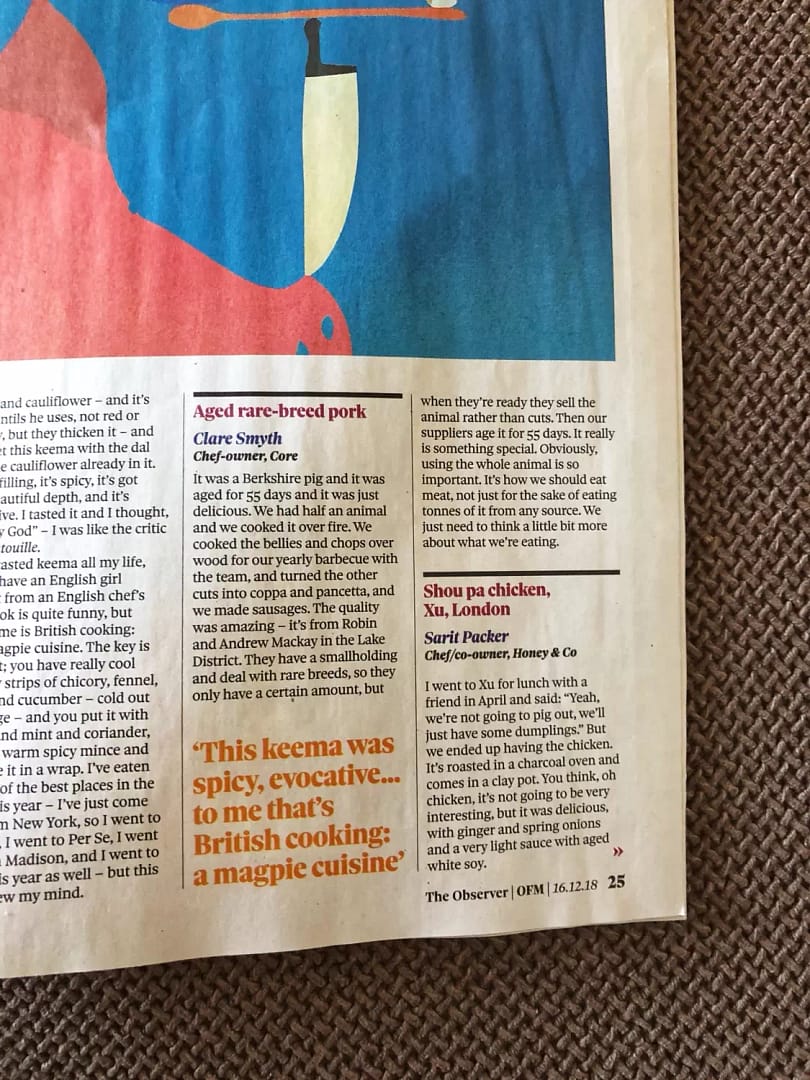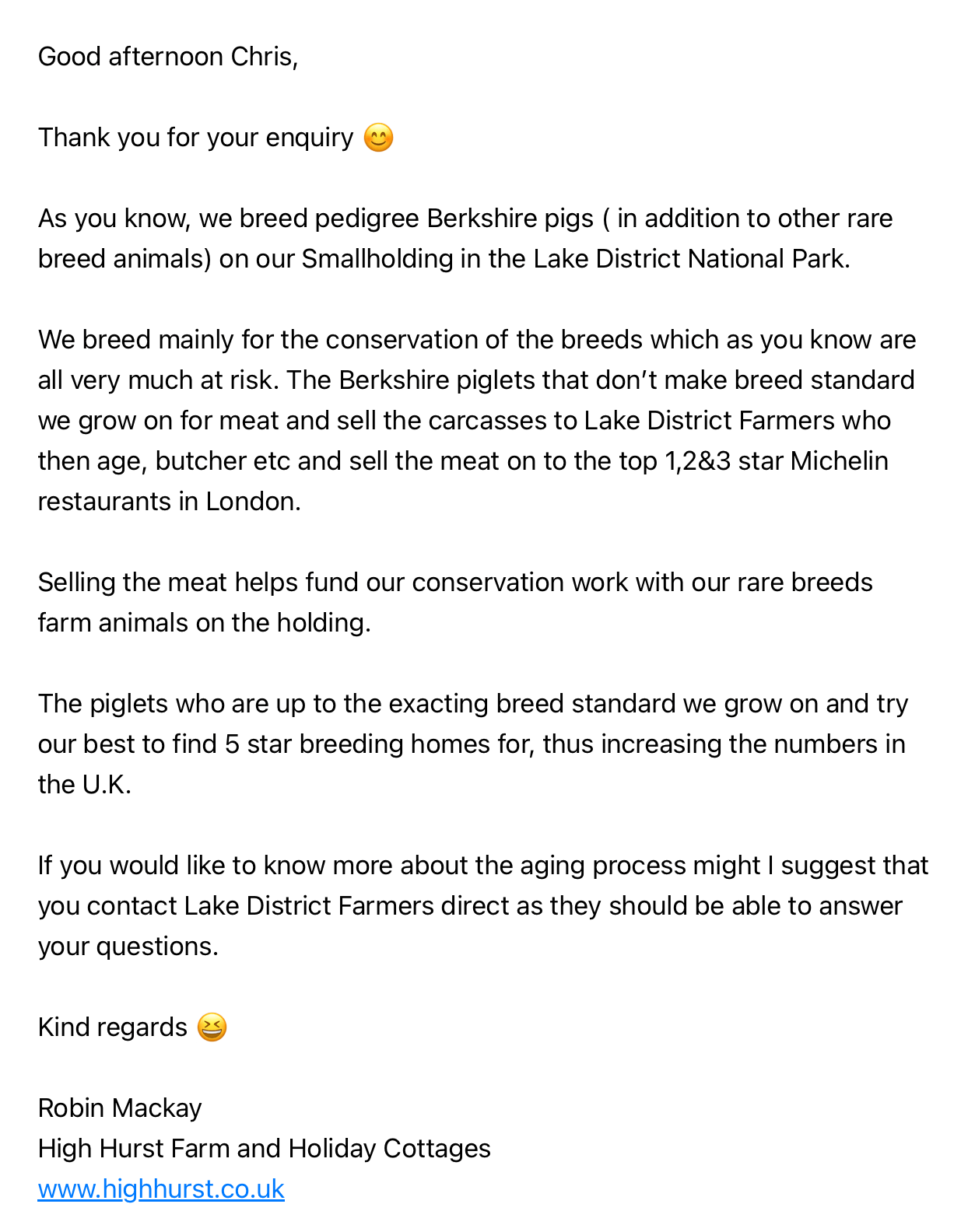There’s a much longer piece on both their histories in the reference section here and here but this synopsis brings them back, front and centre in the blog. Today’s post was prompted by 1. an old article that I’d preserved — dating back to 2018 — that I came across again today, whilst trawling through and weeding out my decaying notes…

…and 2. a subsequent email reply to me from Robin (one of the farmer couple referenced in the piece) who I’d asked about their small-holding and conservation work — with both the Berkshire and GOS breeds — and who should be celebrated and called-out for the work that they do. It’s HARD.
Go and support them. Rent a cottage, buy a pig.

Both pieces repay reading and my thanks to them for this and the pointer to yet more research available on the ageing process, via The Lake District Farmers.
So you might well think that an alien visiting England, would be perplexed by our approach to taste?
We take great pleasure in learning and researching and talking about the unique aromas and flavours of almost every food variety imaginable, from grapes to coffee beans, hops to herbs, and spices to tea leaves.
Shit, even the very strain of yeast that we choose to use to bake our bread with, is now open for debate. And yet, although around 95 per cent of us still consume meat, very few of us yet ever consider the breed of cow, chicken or pig we eat.
We really, really should, you know?
Britain can — yet too often doesn’t —boast of a rich heritage of regional speciality animals and the meat produced from them is simply just delicious, it is easily distinguishable by taste — the result of hundreds of years of pedigree breeding.
Whilst, as you now, my abiding love for the Berkshire yields to nothing to nothing and no one, none the less, if any one pig illustrates this more than any other, it is possibly the Gloucestershire Old Spot; a breed that like all of them at one time faced extinction, yet now is known (and therefore sought out) world-wide for its unique texture, marbling and that taste.
Whilst, like all “origin stories” there’s no canonical research on where or when the breed was first developed, it is believed to have originated around Berkeley Vale along the shores of the River Severn, where local smallholders crossed the original Gloucestershire pig — a large, off-white variety — with the unimproved Berkshire, a sandy-coloured prick-eared pig with spots. The resulting porker was usually kept in local cider and perry pear orchards, where it gorged on windfall fruit—thus the local folklore that says that the pig’s inky black spots are bruises from the falling apples…
The Last Emperor’s order?
Highly prized for its meat (as well as its proverbially easy-going temperament), the breed flourished throughout the 18/1900s and in 1913, the Gloucestershire Old Spots Breed Society was launched to help protect its pedigree. One year later and the reputation of the pig was in such rude health that the German Kaiser himself is purported to have ordered and paid for a consignment of Old Spot to be shipped to Germany. However, around that time, everyone in Europe decided to attack everyone else, the First World War shortly afterwards broke out, the pig(s) was/were never sent and the emperor was never remunerated. Sorry Willy.
By the early 1920s, the Old Spot was possibly the most populous pig breed in the country and to meet this new demand, a growing number of breeders began crossing the pig with lower quality animals. Un-fooled, consumers boycotted the breed and the number of purebred pigs plummeted.
The (luckily, not final, as it turns out) nail in the GOS coffin was the development of faster growing breeds, better adapted to intensive farming. By 1973, there were just 100-120 registered sows in existence and around 80% of those were in one herd in Worcestershire owned by a George Styles. Thanks to his retention efforts (and that of other hobby farmers like him), the breed numbers gradually began to increase.
Though there are believed to still be fewer than 1,000 registered breeding females today, in recent years the breed has begun to enjoy another resurgence, fuelled by ongoing interest in taste and provenance from chefs and eaters alike.
Rear me slowly.
More promising still, in 2010 the GOS became the first breed of any species in the world to be awarded Traditional Speciality Guaranteed (TSG) status by the European Union. Like West Country farmhouse cheddar cheese, Melton Mowbray pork pies and Cornish sardines, any pork product boasting the Traditionally Farmed Gloucestershire Old Spots Pork name must now adhere to a number of strict rules:
Both parents must be registered pedigree Gloucestershire Old Spots; all pigs must be reared slowly from birth to slaughter in an environment that enables them to grow at a natural rate; the application of medication should be avoided unless absolutely necessary; routine tail docking and teeth clipping are not permitted; and slaughter must take place in small-scale abattoirs to minimise stress. Finally, Old Spot carcases must be hung on the bone for a period of three to four days from slaughter.
GOS Society
The pork produced in this way isn’t just better for the welfare of the animal, it results in a palpably distinctive meat. A consumer-led study undertaken by Bristol University found that meat produced from GOS pigs not only boasted increased fat thickness but also greater retention of moisture than the modern breeds, those reared on an industrial scale. Who knew, eh?
And an independent tasting panel found that the pork was thus both juicier and more tender — proof if ever you needed it that, the quality of your meat is only as good as the quality of the animal it came from.
The moral of this brief piece is this, simply “eat possibly less meat, but eat better meat”. You know it makes sense…